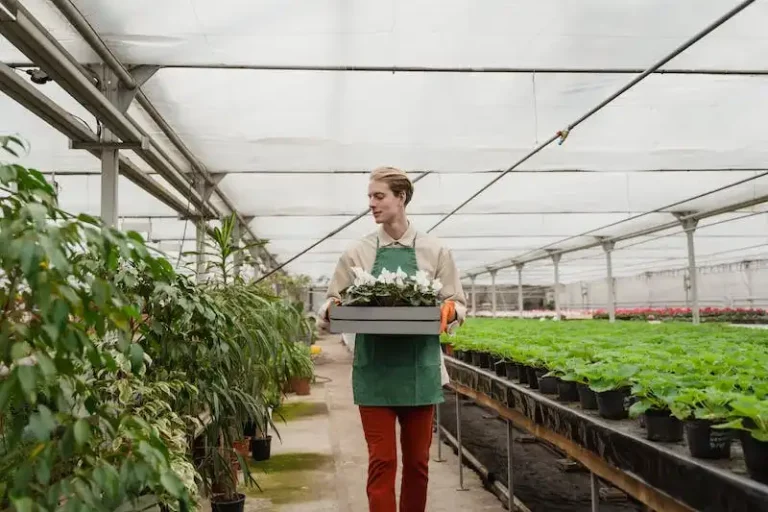If you’re an indoor plant enthusiast, you probably know that Monstera Deliciosa is one of the most popular choices. This plant, also known as the Swiss Cheese plant, is native to the rainforests of Central America and is loved for its large, glossy leaves with unique holes and splits.
However, the Monstera Deliciosa can be a bit tricky to care for, especially for beginners. It requires specific soil, light, and watering conditions to thrive. But don’t worry! In this article, we’ve gathered expert tips to help you take the best care of your Monstera Deliciosa and keep it healthy and beautiful all year round.
1. Choose the Right Placement
When it comes to placing your Monstera Deliciosa indoors, it’s important to find the right spot for it to thrive. This plant prefers bright, indirect light, so placing it near a north or east-facing window is ideal. Avoid direct sunlight as it can scorch the leaves. If you notice your Monstera’s leaves turning yellow, it may be getting too much light.
2. Find the Perfect Potting Soil
The Monstera Deliciosa has specific soil requirements to ensure optimal growth. It prefers well-draining potting soil that retains some moisture but doesn’t stay soggy. A mix of peat moss, perlite, and regular potting soil is a good choice. Avoid using heavy soil or garden soil, as this can lead to overwatering and root rot.
3. Watering Tips
Watering your Monstera Deliciosa correctly is crucial for its health. It’s important to let the top inch or two of soil dry out between waterings. Stick your finger into the soil – if it feels dry, it’s time to water. Be sure not to overwater, as this can lead to root rot. Make sure the water drains properly from the bottom of the pot to avoid waterlogging.
4. Propagation Made Easy
If you’re feeling adventurous, you can try propagating your Monstera Deliciosa. Simply cut a healthy stem with a few leaves and place it in water or moist soil. After a few weeks, you’ll start to see roots forming. Once the roots are about an inch long, you can transfer the cutting into a pot with well-draining soil. Keep it in a warm and humid environment, and it will grow into a new plant.
5. Dealing with Common Problems
Like any other plant, Monstera Deliciosa can face seasonal issues. One common problem is yellowing leaves, which can be caused by overwatering or not enough light. If you notice wilting leaves, it may be a sign of underwatering. Brown tips can indicate dry air, so consider misting your plant or using a humidifier.
6. Keep an Eye on Plant Health
Regularly inspect your Monstera Deliciosa for any signs of pests or diseases. Common pests include spider mites and mealybugs, which can be treated with insecticidal soap. If you notice any brown spots or discoloration on the leaves, it may be a sign of nutrient deficiencies. Consider adding a balanced fertilizer to support your plant’s growth.
7. Bonus Expert Tip: Encourage Bushier Growth
If you prefer a bushier Monstera Deliciosa, you can encourage branching by cutting off the tip of the main vine. This will stimulate new growth from the nodes below the cut. Additionally, higher humidity levels can also promote bushier growth.
By following these expert tips, you can ensure that your Monstera Deliciosa remains healthy, vibrant, and a beautiful addition to your indoor plant collection.
Sources:
Alexandra, I. ( 2025, May 17). “7 Expert Tips To Take Care Of Your Monstera Deliciosa Indoor Plant”. The Gardener’s Journal. https://www.gardenersjournal.com/7-expert-tips-to-take-care-of-your-monstera-deliciosa-indoor-plant/
How to Grow and Care for a Swiss Cheese Plant
The Swiss Cheese Plant, also known as Monstera Deliciosa, is a popular indoor plant loved for its iconic leaves with unique hole patterns. If you’re considering adding this beautiful plant to your indoor collection, here are 7 expert tips to help you grow and care for it.
|
1. Light: |
Place your Swiss Cheese Plant in a bright, indirect light spot. While it can tolerate lower light levels, it thrives in bright, filtered light. |
|
2. Soil: |
Choose a well-draining soil mix for your plant. This will prevent the roots from sitting in soggy soil, which can lead to root rot. |
|
3. Watering: |
Water your Swiss Cheese Plant when the top inch of soil feels dry. Avoid over-watering, as this can cause root rot. It’s better to underwater than to overwater. |
|
4. Repotting: |
Repot your Swiss Cheese Plant every 12-18 months, or when you see its roots coming out of the bottom of the pot. Choose a pot that is one size larger and use a well-draining soil mix. |
|
5. Support: |
As the Swiss Cheese Plant grows, it will need support to climb and grow vertically. You can use a moss pole or a trellis to provide support and encourage upward growth. |
|
6. Propagation: |
You can propagate your Swiss Cheese Plant through stem cuttings. Cut a stem below a node and place it in water or directly into moist soil. It will develop roots and start growing into a new plant. |
|
7. Common Problems: |
The most common problems for Swiss Cheese Plants are brown leaves, which can be caused by over-watering or low humidity. Keep the humidity levels high by misting the leaves or placing a tray of water near the plant. |
By following these expert tips, you’ll be able to grow and care for your Swiss Cheese Plant, and enjoy its beautiful leaves and bushier growth. If you have any more questions, check out the FAQs section or consult with a plant care expert.
Plant Care
When it comes to taking care of your Monstera Deliciosa indoor plant, there are several important factors to consider. From proper watering to adequate lighting, here are some expert tips to help you keep your plant healthy and thriving.
- Lighting: Monstera plants prefer bright, indirect light. Place them near a window where they can receive filtered sunlight. Avoid placing them in direct sunlight, as this can cause their leaves to burn.
- Watering: Monstera plants require regular watering, but they don’t like to sit in water. Allow the top inch of soil to dry out before watering again. Overwatering can lead to root rot and other health issues.
- Repotting: Repot your Monstera plant every 12-18 months or when it outgrows its current pot. Choose a pot that is at least 2 inches wider and deeper than the current one. This will give the roots more room to grow and help the plant thrive.
- Moisture: Monstera plants like to have moist soil, but not soggy. Make sure the soil is evenly moist, but not waterlogged. It’s also a good idea to mist the leaves with water to increase humidity.
- Fertilizing: Feed your Monstera plant with a balanced liquid fertilizer every 2-4 weeks during the growing season (spring and summer). Follow the instructions on the fertilizer packaging for the best results.
- Temperature and Humidity: Monstera plants prefer temperatures between 65-85°F (18-29°C) and humidity levels between 40-60%. They can tolerate lower humidity, but it’s best to keep them in a humid environment, especially during the winter months when indoor air tends to be dry.
- Pruning: To keep your Monstera plant healthy and bushier, prune any leggy or yellowing stems. Cut just above a node to encourage new growth. You can also trim any dead or damaged leaves.
- Placement: Place your Monstera plant in a spot where it can have room to grow. They can reach heights of up to 10 feet (3 meters) indoors, so choose a sturdy pot or consider using a moss pole for support. You may need to rotate the plant periodically to ensure even growth.
- Pest Control: Monstera plants can be prone to pests such as spider mites and mealybugs. Regularly inspect your plant for any signs of infestation, such as webbing or tiny white bugs. If you notice any pests, remove them manually or use an organic pest control solution.
By following these expert tips, you’ll be able to provide the best care for your Monstera Deliciosa indoor plant and enjoy its beautiful foliage year-round. Remember, each plant is unique, so it’s important to observe and adjust your care routine as needed.
Best Growing Conditions for Swiss Cheese Plant
Proper growing conditions are crucial for the health and growth of your Swiss Cheese Plant, also known as Monstera Deliciosa. By providing the optimal environment, you can ensure that your indoor plant thrives and continues to add character to your home. Here are some expert tips to help you create the best growing conditions for your Swiss Cheese Plant:
- Lighting: Swiss Cheese Plants do well in bright, indirect light. Avoid placing them in direct sunlight as it can scorch their leaves. Choose a location where they can receive medium to bright indirect light throughout the day.
- Temperature: These plants prefer temperatures between 65-85°F (18-30°C). They can tolerate lower temperatures during the winter months, but it’s best to avoid drastic temperature fluctuations.
- Air Humidity: Swiss Cheese Plants thrive in higher humidity levels. If the air in your home is dry, you can increase humidity by misting the leaves regularly or placing a humidifier nearby.
- Watering: Water your Swiss Cheese Plant moderately, allowing the top inch of soil to dry out between waterings. Overwatering can lead to root rot, while underwatering can cause wilting and brown tips on the leaves. Find a balance and adjust accordingly based on the moisture needs of your specific plant.
- Soil: Swiss Cheese Plants grow best in well-draining potting soil. You can create a suitable mix by using a combination of peat moss, perlite, and organic matter. Make sure the pot has drainage holes to prevent waterlogging.
- Repotting: Swiss Cheese Plants generally need to be repotted every 12-24 months. When you see the roots starting to emerge from the drainage holes or if the plant becomes root-bound, it’s time to repot. Choose a slightly larger pot and fresh potting soil to support their growth.
- Propagation: Swiss Cheese Plants can be propagated through stem cuttings. Take a cutting with a few aerial roots and place it in water or moist soil until roots develop. Once rooted, you can transfer it to a new pot for further growth.
By following these tips and providing the best growing conditions, you’ll ensure that your Swiss Cheese Plant stays healthy and thrives indoors. Pay attention to their seasonal needs, including lighting and watering, and adjust accordingly. With proper care, your Swiss Cheese Plant will reward you with its striking appearance and lush foliage.




